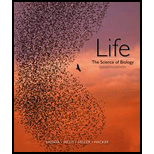
Life: The Science of Biology
11th Edition
ISBN: 9781319010164
Author: David E. Sadava, David M. Hillis, H. Craig Heller, Sally D. Hacker
Publisher: W. H. Freeman
expand_more
expand_more
format_list_bulleted
Question
Chapter 14.4, Problem 3R
Summary Introduction
To review:
The discrepancies that would occur if a gene of 1,440 base pairs codes for a polypeptide chain of 192 amino acids.
Introduction:
The code on deoxyribonucleic acid (DNA) in the form of
Expert Solution & Answer
Want to see the full answer?
Check out a sample textbook solution
Students have asked these similar questions
The mass of a gene is 32,400 units. The amount of introns is twice the amount of exons. What is the mass of protein that encodes this gene, if the mass of the amino acid is 110 and the nucleotide is 300 units.
In the human genome for the beta chain of haemoglobin (the oxygen-carrying protein in the red blood cells), the first 30 nucleotide in the amino acid coding region is represented by the sequence
3'-TACCACGTGGACTGAGGACTCCTCTTCAGA-5'
Given the following Wild Type and Mutated DNA sequences:
1.) Identify where the base pair change occurs ( what letter changed?)
2.) For BOTH sequences, write the mRNA strands, define the codon regions and amino acid sequences.
3.) Describe what kind of mutation has occurred (missense, nonsense, or silent), and what effect this may have on the protein.
Wild Type DNA Sequence: 3' - AGGCTCGCCTGT - 5'
Mutated DNA Sequence: 3' - AGTCTCGCCTGT - 5'
Chapter 14 Solutions
Life: The Science of Biology
Knowledge Booster
Similar questions
- A gene contains 30% thymine. What is the percentage of pyrimidines present in this segment? Explain.arrow_forwardFor the following sequence, what is the Tm? 5'-AGCTACGATCAGGTCA-3'arrow_forwardThe protein encoded by the cystic fibrosis gene is 1480amino acids long, yet the gene spans 250 kb. How is thisdifference possible?arrow_forward
- Human Chromosome 22 (48 × 106 nucleotide pairs in length) has about 700 protein-coding genes, which average 19,000 nucleotide pairs in length and contain an average of 5.4 exons, each of which averages 266 nucleotide pairs. What fraction of the average protein-coding gene is converted into mRNA? What fraction of the chromosome do these genes occupy?arrow_forward5'......TACTGCCCATGCCCAGAGAGAAAGCGCAGACGCGTCTAAactgt... 3' a). (10 points). In the above sequences, the open reading frame is indicated by alternating non-underlined and underlined triplets. Please use the codon table to deduce the amino acid sequence for the region shown in the wildtype protein. Wildtype AA sequence for the region around mutation #1: Wildtype AA sequence for the region around mutation #2: b). (10 points). Please make predictions what molecular change mutation #1 and mutation #2 cause. c). (5 points). Which mutation is more likely to abrogate the protein function? Why?arrow_forwardGiven the following Wild Type and Mutated DNA sequences: 1.) Identify where the base pair change occurs (what letters changed?) 2.) For BOTH sequences, write the mRNA strands, define the codon regions (with spaces), and amino acid sequences. 3.) Describe what kind of mutation has occurred (missense, nonsense, or silent), and what effect this may have on the protein. Wild Type DNA Sequence: 3' - CCTCGTTATGTG - 5' Mutated DNA Sequence: 3' - CCTCGTTATTTG - 5'arrow_forward
- Consider the following coding sequence transcribed from 5' to 3'5' A T G A A G C G C T C A G T A 3' If a guanine is substituted for nucleotide 11 what type of base substitution has occurred (nucleotide level) and what would be the resulting phenotypic effect?arrow_forwardExplain why polypeptides have such variable sequences.arrow_forwardYou would like to add a nuclear localization sequence (NLS) of Lys-Lys-Lys-Arg-Lys to a protein that is usually found in the cytoplasm of a yeast cell. To accomplish this, you introduce the nucleotide sequence encoding the NLS into the gene that encodes the cytoplasmic protein of interest. a. What is the size of the nucleotide insert that will encode the NLS? Briefly explain. 5' 3' b. Below is a diagram of the gene encoding the cytoplasmic protein of interest in the yeast genome. If your goal is to put the NLS at the carboxyl (C) terminus of the protein, at which location (A-E) should the NLS be inserted? Briefly explain. A TATAA ATATT promoter +1 B ATG TAC D TAA ATT stop codon E 3' 5'arrow_forward
- Explain why it is sometimes difficult to locate genomic regions that encode a protein.arrow_forwardPlease helparrow_forwardThe gene encoding the E. coli enzyme enolase begins with the sequence ATGTCCAAAATCGTA. What is the sequence of the RNA transcript specified by this part of the gene? (5') (3¹')arrow_forward
arrow_back_ios
SEE MORE QUESTIONS
arrow_forward_ios
Recommended textbooks for you
 Human Heredity: Principles and Issues (MindTap Co...BiologyISBN:9781305251052Author:Michael CummingsPublisher:Cengage Learning
Human Heredity: Principles and Issues (MindTap Co...BiologyISBN:9781305251052Author:Michael CummingsPublisher:Cengage Learning Biology: The Dynamic Science (MindTap Course List)BiologyISBN:9781305389892Author:Peter J. Russell, Paul E. Hertz, Beverly McMillanPublisher:Cengage Learning
Biology: The Dynamic Science (MindTap Course List)BiologyISBN:9781305389892Author:Peter J. Russell, Paul E. Hertz, Beverly McMillanPublisher:Cengage Learning

Human Heredity: Principles and Issues (MindTap Co...
Biology
ISBN:9781305251052
Author:Michael Cummings
Publisher:Cengage Learning

Biology: The Dynamic Science (MindTap Course List)
Biology
ISBN:9781305389892
Author:Peter J. Russell, Paul E. Hertz, Beverly McMillan
Publisher:Cengage Learning